JEE Advanced (Subjective Type Questions): Definite Integrals & Applications of Integrals - 2 | Chapter-wise Tests for JEE Main & Advanced PDF Download
Q. 17. If f and g are continuous function on [0, a] satisfying f(x) = f(a – x) and g(x) + g(a – x) = 2, then show that (1989 - 4 Marks)
Solution.
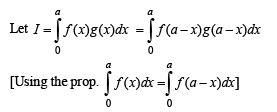


Hence the result.
Q. 18. Show that  (1990 - 4 Marks)
(1990 - 4 Marks)
Solution.
 ...(1)
...(1) ...(2)
...(2)
Adding (1) and (2), we get
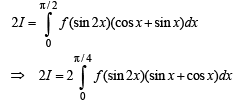
[Using the property,



 Hence Proved.
Hence Proved.
Q. 19. Prove that for any positive integer k,  2[cos x + cos 3x + .............. + cos (2k – 1) x] (1990 - 4 Marks)
2[cos x + cos 3x + .............. + cos (2k – 1) x] (1990 - 4 Marks)
Hence prove that 
Solution. To prove : 
It is equivalent to prove that
sin 2kx = 2 sin x cos x + 2 cos 3x sinx+ ... + 2 cos(2k- 1) x sinx
Now, R.H.S. = (sin2 x) + (sin4 x- sin2x) + (sin6 x- sin4x) +.... +(sin 2kx - sin(2k- 2)x)
= sin2kx = L.H.S. Hence Proved.

[Using the identity proved above]
 +2 cos(2k- 1) x cos x]dx
+2 cos(2k- 1) x cos x]dx
 +(cos 6 x + cos 4x) + (cos 2kx) + cos(2k- 2) x ]dx
+(cos 6 x + cos 4x) + (cos 2kx) + cos(2k- 2) x ]dx
 cos(2k- 2)x] + cos 2 k x dx
cos(2k- 2)x] + cos 2 k x dx


= π /2 
Hence Proved
Q. 20. Compute the area of the region bounded by the curves y = ex In x and  (1990 - 4 Marks)
(1990 - 4 Marks)
Ans. 
Solution. The given curves are
y = ex logex … (1)
and  … (2)
… (2)
The two curves intersect where ex log x 

At x = 1/e or ex = 1, log x = - log e =-1,y =-1
So that  is one point of intersection and at x = 1,
is one point of intersection and at x = 1,
log 1 = 0 ∴ y = 0
∴ (1, 0) is the other common point of intersection of the curves. Now in between these two points, 

i.e. log x is – ve, throughout

Clearly under the condition stated above y1 < y2 both being –ve in the interval 
The rough sketch of the two curves is as shown in fig. and shaded area is the required area.

∴ The required area = shaded area


Q. 21. Sketch the curves and identify the region bounded by x = 1/2, x = 2, y = In x and y = 2x. Find the area of this region. (1991 - 4 Marks)
Ans. 
Solution. The given curves are x = 1/2 ....(1), x = 2...(2), y = ln x...(3),y = 2x....(4)
Clearly (1) and (2) represent straight lines parallel to y - axis at distances 1/2 and 2 units from it, respectively. Line x = 1/2 meets  meets (3) at (2, ln 2) and (4) at (2, 4).
meets (3) at (2, ln 2) and (4) at (2, 4).
The graph of curves are as shown in the figure.

Required area = ABCDA
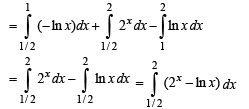

Q. 22. If ‘f’ is a continous function with  then show that every line y = mx
then show that every line y = mx
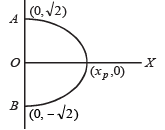
intersects the curve  (1991 - 4 Marks)
(1991 - 4 Marks)
Solution. We are given that f is a continuous function and

To sh ow that ever y line y = mx intersects the curve

If possible, let y = mx intersects the given curve, then Substituting y = mx in the equation of the curve we get


Then F (x) is a continuous function as f (x) is given to be continuous.
Also F ( x) → ∞ as |x|→ ∞
But F (0) = –2
Thus F (0) = –ve and F(b) = +ve where b is some value of x, and F (x) is continuous.
Therefore F (x) = 0 for some value of x Î (0,b) or eq. (1) is solvable for x.
Hence y = mx intersects the given curve.
Q. 23.  (1991 - 4 Marks)
(1991 - 4 Marks)
Ans. 
Solution.

Consider, 2x - p = y n ⇒ 
When x → 0,y → -π when x → π ,y → π
∴ We get






⇒ cos y / 2 dy = 2du
Also as y → 0,u → 0 and as y → π,u → 1


Q. 24. Sketch the region bounded by the curves y = x2 and  Find the area. (1992 - 4 Marks)
Find the area. (1992 - 4 Marks)
Ans. 
Solution. The given curves are y = x2 and  Here y = x2 is upward parabola with vertex at origin.
Here y = x2 is upward parabola with vertex at origin.
Also,  is a curve symm. with respect to y-axis.
is a curve symm. with respect to y-axis.
At x = 0,y = 2

∴ Curve is decreasing on (0, ∞)

⇒ At (0,2) tangent to curve is parallel to x – axis.
As x → ∞ , y → 0
∴ y = 0 is asymptote of the given curve.
For the given curves, point of intersection : solving their equations we get x = 1, y = 1, i.e., (1,1).
Thus the graph of two curves is as follows:

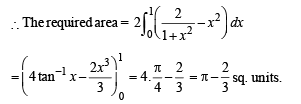
Q. 25. Determine a positive integer n < 5,such that  (1992 - 4 Marks)
(1992 - 4 Marks)
Ans. n = 3
Solution. Given that 
where n ∈ N and n < 5
To find the value of n.

 .........(1)
.........(1)


Q. 26. (1993 - 5 Marks)
(1993 - 5 Marks)
Ans. 
Solution.


Put x2 + 1 = t ,2 x dx = dt
when x → 2,t → 5 , x → 3,t → 10


Q. 27. Show that  where n is a positive integer and 0 < n < π. (1994 - 4 Marks)
where n is a positive integer and 0 < n < π. (1994 - 4 Marks)
Ans. 2n + 1 - cosγ
Solution. To prove that 

Now we know that | sin x| is a periodic function of period π , So using the property..

where n ∈ I and f (x) is a periodic function of period T



Q. 28. In what ratio does the x-axis divide the area of the region bounded by the parabolas y = 4x – x2 and y = x2 – x ? (1994 - 5 Marks)
Ans. 121 : 4
Solution. The given equations of parabola are
y = 4 x - x2 or (x - 2)2 = -(y- 4) ..... (1)
 ...... (2)
...... (2)
Solving the equations of two parabolas we get their points of intersection as 
Here the area below x - axis,


Area above x - axis,



∴ Ratio of areas above x – axis and below x – axis.

Q. 29.  Use mathematical induction to prove that Im = m π , m = 0, 1, 2, ....... (1995 - 5 Marks)
Use mathematical induction to prove that Im = m π , m = 0, 1, 2, ....... (1995 - 5 Marks)
Solution. Given 
To prove: Im = mπ,m= 0, 1, 2, ......
For m = 0

∵ Result is true for m = 0
For m = 1,

∴ Result is true for m = 1
Let the result be true for 
Consider 
Now, 1 - cos(k+ 1)x
= 1 – cos kx cosx + sin kx sin x
= 1 + cos kx cos x + sin kx sin x – 2 cos kx cos x
= 1 + cos (k – 1) x – 2 cos kx cos x
= 2 – (1 – cos (k – 1) x) –2 cos kx cos x
= 2 (1 – cos kx cos x) – (1– cos (k – 1) x)
= 2 – 2 cos kx + 2 cos kx – 2 cos kx cos x – [1– cos ( k – 1) x]
= 2 (1 – cos kx) + 2 cos kx (1– cos x) – (1 – cos (k – 1) x)



= 2 (kπ) + 2(0) - (k - 1)π [Using (i)]
= 2kπ- kπ+π = (k +1)π
Thus result is true for m=k + 1 as well. Therefore by the principle of mathematical induction, given statement is true for all m = 0, 1, 2, ...............
Q. 30. Evaluate the definite integral :  (1995 - 5 Marks)
(1995 - 5 Marks)
Ans. 
Solution.







Q. 31. Consider a square with vertices at (1, 1), (– 1, 1), (– 1, – 1) and (1, – 1). Let S be the region consisting of all points inside the square which are nearer to the origin than to any edge. Sketch the region S and find its area. (1995 - 5 Marks)
Ans. 
Solution. Let us consider any point P (x, y) inside the square such that its distance from origin < its distance from any of the edges say AD

 ........ (1)
........ (1)
Above represents all points within and on the parabola 1. If we consider the edges BC then OP < PN will imply
 ........ (2)
........ (2)
Similarly if we consider the edges AB and CD, we will have
 ........ (3)
........ (3)
 ........ (4)
........ (4)
Hence S consists of the region bounded by four parabolas meeting the axes at 
The point L is intersection of P1 and P3 given by (1) and (3).

y2 - x2 = -2( x - y) = 2( y-x) 0
∴ y - x = ∴ y = x ∴ x2 + 2x - 1 = 0 ⇒ (x + 1)2 = 2



Q. 32. Let An be the area bounded by the curve y = (tan x)n and the lines x = 0, y = 0 and x = π/4. Prove that for n > 2,  and deduce
and deduce  (1996 - 3 Marks)
(1996 - 3 Marks)
Solution.


Since 0 < tan x < 1, when 0 < x < π /4 , we have
0 < (tan x)n +1 < (tanx)n for each n ∈ N

Now, for n > 2





 ........(2)
........(2)
Combining (1) and (2) we get
 Hence Proved.
Hence Proved.
|
446 docs|929 tests
|





















